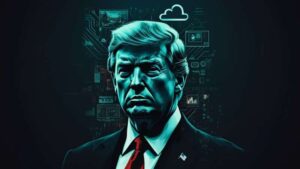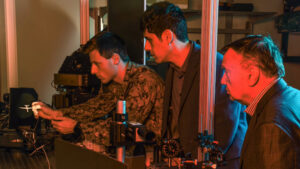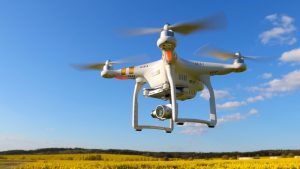Featured
 Government, Industry, Academia Collaboration Fuels AI Progress
Government, Industry, Academia Collaboration Fuels AI Progress
From artificial intelligence (AI)-powered digital assistants that guide citizens through state portals to digital twins that model transportation infrastructure, state and local governments are finding practical pathways to put AI to work.
-
 Trump Signs Order to Preempt State AI Laws and Push Single Federal Framework
President Donald Trump signed an executive order Thursday to undermine state laws on artificial intelligence (AI), calling instead for a “minimally burdensome” single framework to regulate the AI industry.
Trump Signs Order to Preempt State AI Laws and Push Single Federal Framework
President Donald Trump signed an executive order Thursday to undermine state laws on artificial intelligence (AI), calling instead for a “minimally burdensome” single framework to regulate the AI industry. -
 Indiana DOE Partnership Targets STEM, Digital Learning Tools
The Indiana Department of Education (IDOE) announced a new public-private partnership that will provide $75 million advance the state’s education priorities, including bolstering science, technology, engineering, and math (STEM) education and digital learning tools.
Indiana DOE Partnership Targets STEM, Digital Learning Tools
The Indiana Department of Education (IDOE) announced a new public-private partnership that will provide $75 million advance the state’s education priorities, including bolstering science, technology, engineering, and math (STEM) education and digital learning tools. -
 States, Schools Harness Data and Workforce Programs to Combat Fraud, Cyber Threats, and Service Outages
Public sector and higher education leaders are actively developing innovative data analytics and cybersecurity workforce models to combat escalating fraud and cyber threats.
States, Schools Harness Data and Workforce Programs to Combat Fraud, Cyber Threats, and Service Outages
Public sector and higher education leaders are actively developing innovative data analytics and cybersecurity workforce models to combat escalating fraud and cyber threats.
Recent News
-
 Dartmouth Rolls Out AI Program With Anthropic, AWS
Dartmouth College has rolled out a campuswide artificial intelligence (AI) initiative through a new partnership with Anthropic and Amazon Web Services (AWS), giving students, faculty, and staff access to Anthropic’s Claude for Education model and AWS’s Amazon Bedrock platform.
Dartmouth Rolls Out AI Program With Anthropic, AWS
Dartmouth College has rolled out a campuswide artificial intelligence (AI) initiative through a new partnership with Anthropic and Amazon Web Services (AWS), giving students, faculty, and staff access to Anthropic’s Claude for Education model and AWS’s Amazon Bedrock platform. -
 Education, Enterprise Compute, and Hands-On Sprints Turn Into Mission Impact
The Naval Postgraduate School (NPS) is building an artificial intelligence (AI)-ready force the way a teaching hospital trains clinicians: rigorous classroom learning, side-by-side practice on world-class technology, and real problems. Through its Artificial Intelligence Task Force (AITF), Digital Trident AI Challenge, and academic and leadership programs, NPS pairs tiered AI education with secure, scalable compute and operator-in-the-loop experimentation so students and faculty can turn promising ideas into useful capabilities that commands can adopt.
Education, Enterprise Compute, and Hands-On Sprints Turn Into Mission Impact
The Naval Postgraduate School (NPS) is building an artificial intelligence (AI)-ready force the way a teaching hospital trains clinicians: rigorous classroom learning, side-by-side practice on world-class technology, and real problems. Through its Artificial Intelligence Task Force (AITF), Digital Trident AI Challenge, and academic and leadership programs, NPS pairs tiered AI education with secure, scalable compute and operator-in-the-loop experimentation so students and faculty can turn promising ideas into useful capabilities that commands can adopt. -
 ISC2 Report: Cyber Experts Say They Need Skills More Than Headcount
As global cybersecurity hiring begins to stabilize after years of layoffs and frozen budgets, skills gaps loom large as one of the greatest challenges facing the cybersecurity workforce, the new annual ISC2 Cybersecurity Workforce Study found.
ISC2 Report: Cyber Experts Say They Need Skills More Than Headcount
As global cybersecurity hiring begins to stabilize after years of layoffs and frozen budgets, skills gaps loom large as one of the greatest challenges facing the cybersecurity workforce, the new annual ISC2 Cybersecurity Workforce Study found.

Download the issue brief to learn how Workday addresses budget, workforce, and financial reporting challenges with a unified platform that brings finance and workforce management together on one intelligent data core.
-
 New Jersey Launches Civilian Cyber Corps
A new cybersecurity initiative dubbed the New Jersey Civilian Cyber Resilience Corps (Cyber Corps) aims to mobilize specialized expertise in cybersecurity response and resilience across the state of New Jersey.
New Jersey Launches Civilian Cyber Corps
A new cybersecurity initiative dubbed the New Jersey Civilian Cyber Resilience Corps (Cyber Corps) aims to mobilize specialized expertise in cybersecurity response and resilience across the state of New Jersey. -
 Pennsylvania National Guard Expands Drone Use
The Pennsylvania National Guard is expanding training and testing of unmanned aircraft systems (UAS) – commonly referred to as drones – as they take on a growing role in modern warfare.
Pennsylvania National Guard Expands Drone Use
The Pennsylvania National Guard is expanding training and testing of unmanned aircraft systems (UAS) – commonly referred to as drones – as they take on a growing role in modern warfare. -
 Texas A&M University System Names Vince Kellen CIO
The Texas A&M University System named Vince Kellen as its next chief information officer (CIO) with his appointment effective Dec. 1, the university said in a press release.
Texas A&M University System Names Vince Kellen CIO
The Texas A&M University System named Vince Kellen as its next chief information officer (CIO) with his appointment effective Dec. 1, the university said in a press release. -
 FTC Hits Illuminate for Student Data Breach, Discusses Settlement Terms
The Federal Trade Commission (FTC) said on Dec.1 that a majority of its commissioners approved the agency taking legal action against edtech services provider Illuminate following a breach, “which allowed hackers to access the personal data of more than 10 million students.”
FTC Hits Illuminate for Student Data Breach, Discusses Settlement Terms
The Federal Trade Commission (FTC) said on Dec.1 that a majority of its commissioners approved the agency taking legal action against edtech services provider Illuminate following a breach, “which allowed hackers to access the personal data of more than 10 million students.”
-
Army, Northeastern University Team Up on 3D-Printed Material for Electronics
A coalition of researchers from the U.S. Army and Northeastern University have developed a 3D-printable material designed to keep advanced military electronics from overheating – a growing concern across communication, radar, drone and electric vehicle systems.
-
Senators Introduce Bill to Reauthorize Cybersecurity Grant Program
Sens. Maggie Hassan, D-N.H., and John Cornyn, R-Texas, introduced a bipartisan bill today that would reauthorize the State and Local Cybersecurity Grant Program (SLCGP), a key program that helps state, local, and tribal governments prevent cyberattacks.
-
NYC Launches Emergency Communications Vehicle
New York City Chief Technology Officer (CTO) Matthew Fraser announced on Nov. 25 the launch of an emergency communications vehicle designed to ensure uninterrupted connectivity to the city’s first responder agencies during major events and disaster situations.
-
Georgia to Offer Free AI Training for All State Employees
Georgia state employees will receive free artificial intelligence (AI) training under a new partnership with InnovateUS that will teach public sector workers how to use the technology responsibly.
-
New Bill Would Fund AI Training in Medical Schools
A grant program would annually make $1 million available for medical schools that build artificial intelligence (AI) literacy programs under legislation introduced Wednesday by House Democrats.
-
Bipartisan Lawmakers Urge Republicans Against AI Moratorium in Defense Bill
Members of Congress and state lawmakers are urging congressional Republicans to drop their plans to add language to the National Defense Authorization Act (NDAA) that would place a moratorium on state-level laws regulating artificial intelligence (AI).
-
House Passes Bills to Renew Cyber Grants and Counter Threats From China
The House voted to pass two key cybersecurity-related pieces of legislation on Monday that would renew cybersecurity grants for state and local government until 2033 and stand up an interagency task force to address threats posed by China.
-
Nevada Gov. Signs Off on Statewide Cybersecurity Hub After Major IT Attack
The Nevada state legislature and Gov. Joe Lombardo have approved and signed into law a bill that will stand up a statewide security operations center and grow its cyber workforce.
-
NTIA Approves First Set of Finalized BEAD Proposals
This week, the Department of Commerce’s National Telecommunications and Information Administration (NTIA) approved final proposals from 18 states and territories to deliver universal broadband access through the Broadband Equity, Access, and Deployment (BEAD) program.
-
LA Tech Launches Student-Run Cybersecurity SOC
Louisiana Tech University (LA Tech) is establishing a new student-run security operations center (SOC) to strengthen its security posture, expand its cybersecurity talent pipeline, and attract high-achieving students to campus.